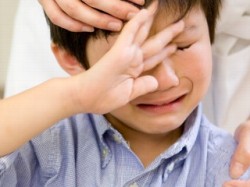Treatment for Childhood Panic Disorder
When children experience panic attacks, it often goes unnoticed or might be dismissed as typical behavior. Many times, the attack might be misdiagnosed as a symptom of an illness or the sign of a tantrum. Unfortunately, just like adults, children also suffer serious anxiety and panic attacks that might be the result of an eating disorder, asthma, depression or other illness, which requires treatment.
Signs and Symptoms
The signs and symptoms of a child’s panic attack could include:
- Shaking and trembling
- An increased heart rate
- Lightheadedness or dizziness
- Sobbing
- Intense worry or fear
- Fear of losing control, losing their mind, or dying
- Rapid breathing or shortness of breath
- A feeling of being detached from reality
Many children that experience a panic disorder show noticeable signs of separation anxiety (the fear physical detachment from a parent). Other children might develop an obsessive-compulsive disorder that often displays itself in ritualistic behaviors and intense worry. They might also experience social anxiety where a high level of fear is easily generated.

Childhood panic disorder is a real disorder that many children are suffering from.
A panic disorder will usually interfere with every aspect of the child’s world including their relationships, schoolwork, activities, and normal development. It often has a direct effect on their functioning and mood. A normal response for a child suffering from panic disorder is to avoid any situation where they might fear the onset of a panic attack.
In fact, the child might avoid the situation when they realize help from their parents or others might not be available. This could include developing a reluctance of being separated from a parent, or going to school. Some children will develop signs of “agoraphobia” where they might be terrified to leave home. Over time, the child could develop severe depression that might drive him or her to suicidal behavior. Older children might turn to drugs or alcohol as a way to control their panic disorder.
Panic Disorder Diagnosis
According to the AACAP (American Academy of Child & Adolescent Psychiatry), diagnosis of panic disorder in adolescents and children can be challenging. It often requires numerous visits to doctors that perform multiple medical tests that could be potentially painful and expensive. However, when the condition has been properly evaluated and accurately diagnosed, children often respond extremely well to treatment.
Highly effective treatments involving specific medications and/or psychotherapy have helped many children and families learn effective strategies for reducing conflict or stress that tend to lead to a panic attack. When properly taught effective techniques (cognitive behavioral therapy), new ways can be learned to control the child’s panic or anxiety attack when it occurs.
With effective treatment, the panic disorder usually goes away. When the child is treated early on in their disorder, many of the techniques help avoid more serious complications of the condition including depression, agoraphobia and substance abuse.
For panic disorder treatment to be its most effective will require a supportive environment. This often requires educating parents and school faculty to identify any pattern of difficulty the child is having in their daily world. The effective treatments will help reduce anxiety and panic attacks at school and home.





